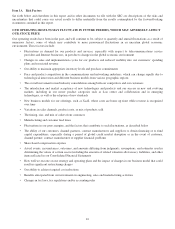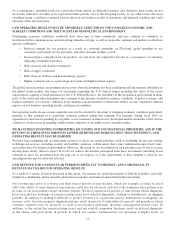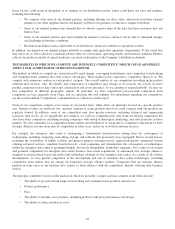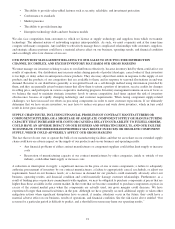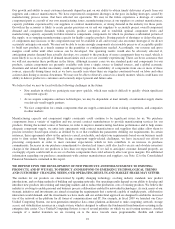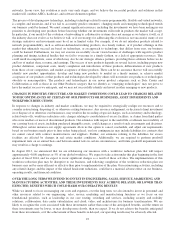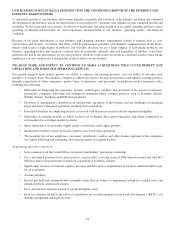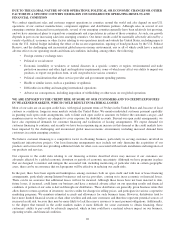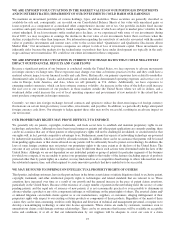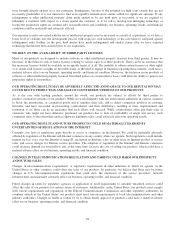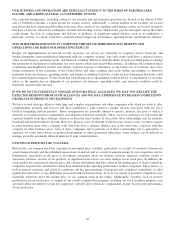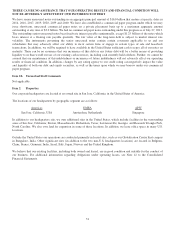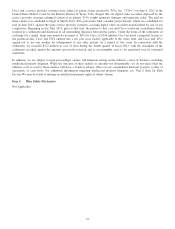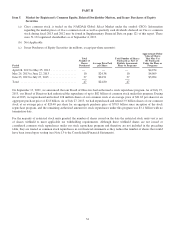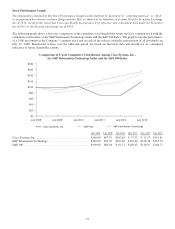Cisco 2013 Annual Report Download - page 34
Download and view the complete annual report
Please find page 34 of the 2013 Cisco annual report below. You can navigate through the pages in the report by either clicking on the pages listed below, or by using the keyword search tool below to find specific information within the annual report.DUE TO THE GLOBAL NATURE OF OUR OPERATIONS, POLITICAL OR ECONOMIC CHANGES OR OTHER
FACTORS IN A SPECIFIC COUNTRY OR REGION COULD HARM OUR OPERATING RESULTS AND
FINANCIAL CONDITION
We conduct significant sales and customer support operations in countries around the world and also depend on non-U.S.
operations of our contract manufacturers, component suppliers and distribution partners. Although sales in several of our
emerging countries decreased in recent periods, several of our emerging countries generally have been relatively fast growing,
and we have announced plans to expand our commitments and expectations in certain of those countries. As such, our growth
depends in part on our increasing sales into emerging countries. Our future results could be materially adversely affected by a
variety of political, economic or other factors relating to our operations inside and outside the United States, including impacts
from the U.S. federal budget including the effect of the recent sequestration, tapering of bond purchases by the U.S. Federal
Reserve, and the challenging and inconsistent global macroeconomic environment, any or all of which could have a material
adverse effect on our operating results and financial condition, including, among others, the following:
• Foreign currency exchange rates
• Political or social unrest
• Economic instability or weakness or natural disasters in a specific country or region; environmental and trade
protection measures and other legal and regulatory requirements, some of which may affect our ability to import our
products, to export our products from, or sell our products in various countries
• Political considerations that affect service provider and government spending patterns
• Health or similar issues, such as a pandemic or epidemic
• Difficulties in staffing and managing international operations
• Adverse tax consequences, including imposition of withholding or other taxes on our global operations
WE ARE EXPOSED TO THE CREDIT RISK OF SOME OF OUR CUSTOMERS AND TO CREDIT EXPOSURES
IN WEAKENED MARKETS, WHICH COULD RESULT IN MATERIAL LOSSES
Most of our sales are on an open credit basis, with typical payment terms of 30 days in the United States and, because of local
customs or conditions, longer in some markets outside the United States. We monitor individual customer payment capability
in granting such open credit arrangements, seek to limit such open credit to amounts we believe the customers can pay, and
maintain reserves we believe are adequate to cover exposure for doubtful accounts. Beyond our open credit arrangements, we
have also experienced demands for customer financing and facilitation of leasing arrangements. We expect demand for
customer financing to continue, and recently we have been experiencing an increase in this demand as the credit markets have
been impacted by the challenging and inconsistent global macroeconomic environment, including increased demand from
customers in certain emerging countries.
We believe customer financing is a competitive factor in obtaining business, particularly in serving customers involved in
significant infrastructure projects. Our loan financing arrangements may include not only financing the acquisition of our
products and services but also providing additional funds for other costs associated with network installation and integration of
our products and services.
Our exposure to the credit risks relating to our financing activities described above may increase if our customers are
adversely affected by a global economic downturn or periods of economic uncertainty. Although we have programs in place
that are designed to monitor and mitigate the associated risk, including monitoring of particular risks in certain geographic
areas, there can be no assurance that such programs will be effective in reducing our credit risks.
In the past, there have been significant bankruptcies among customers both on open credit and with loan or lease financing
arrangements, particularly among Internet businesses and service providers, causing us to incur economic or financial losses.
There can be no assurance that additional losses will not be incurred. Although these losses have not been material to date,
future losses, if incurred, could harm our business and have a material adverse effect on our operating results and financial
condition. A portion of our sales is derived through our distributors. These distributors are generally given business terms that
allow them to return a portion of inventory, receive credits for changes in selling prices, and participate in various cooperative
marketing programs. We maintain estimated accruals and allowances for such business terms. However, distributors tend to
have more limited financial resources than other resellers and end-user customers and therefore represent potential sources of
increased credit risk, because they may be more likely to lack the reserve resources to meet payment obligations. Additionally,
to the degree that turmoil in the credit markets makes it more difficult for some customers to obtain financing, those
customers’ ability to pay could be adversely impacted, which in turn could have a material adverse impact on our business,
operating results, and financial condition.
26


